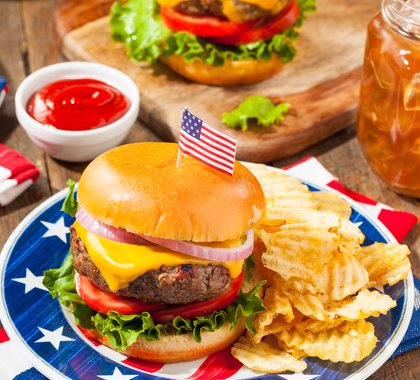What Fast Food and Slow Food Say About American Culture
Imagine two families in America. One family, after a long day of work and school, decides to stop at a drive-thru for a quick dinner of burgers, fries, and soda. They choose fast food because it is convenient, affordable, and fits into their busy schedule. Meanwhile, another family stops at a local farmer’s market to pick up fresh vegetables and then heads home to cook a meal together. They make a homemade vegetable stir-fry, enjoying both the process of cooking and eating together. These different choices—between grabbing fast food and preparing a home-cooked meal—show different priorities in American society. Fast food choices highlight a desire for convenience, speed, and independence, while slow food choices emphasize sustainability, community, and mindfulness. By looking at these two ways of eating, we can see what values shape American culture.

There are more than 200,000 fast food restaurants across the country, including places like McDonald’s, Burger King, and Taco Bell (Wilson). This shows that Americans like food that is easy to get and does not take long to make. People who are busy might choose fast food because it saves time. This tells us that Americans care a lot about convenience—they want things done quickly and easily. Fast food also tends to be cheaper. A meal at a fast-food restaurant can cost just a few dollars, making it an excellent choice for people who want to save money. This shows that in American culture, people often think about saving money when choosing what to eat, even if the food is not the healthiest option.
Even though fast food is popular, it can be bad for health. Eating excessive amounts of fast food is linked to problems like being overweight, heart disease, and diabetes. Forty percent of American adults eat fast food on any given day, even though many know it’s not healthy (Min et al. 590-601). Despite this knowledge, people still choose fast food because it is quick and inexpensive. This shows that sometimes, Americans find it hard to balance what is easy with what is good for their health.
Fast food also has an impact on the environment. The big farms that supply fast food chains often use methods that can hurt the planet, like using chemicals and creating lots of waste. For example, fast food places use packaging, such as paper and plastic, which often ends up in landfills or as litter (Wilson). This reflects a culture that, at times, overlooks environmental care in favor of convenience and saving money. However, there is a growing awareness among Americans about these negative impacts, and people are beginning to look for better food choices that are kinder to the Earth.
The Slow Food movement is different because it focuses on fresh, healthy food that is good for people and the planet. It encourages eating food that is “good, clean, and fair,” which means the food is healthy, grown in a way that does not harm the environment, and is fair to those who grow it (Notaras). Slow food is becoming more popular among Americans who care about the quality of their food and where it comes from. People who choose slow food often buy ingredients from local farmers and spend time cooking meals at home. This choice shows a desire to support local communities and take care of the environment.
Slow food also represents a desire to keep cultural traditions alive. In America, diverse groups use food to celebrate their unique traditions. The Slow Food movement helps protect these traditions by using local ingredients and traditional ways of cooking. For example, in many places in America, Slow Food supports using local, seasonal ingredients, which helps keep regional food traditions alive (Jarito and Vargas). This shows a culture that values diversity and wants to preserve cultural stories through food.
The growth of the Slow Food movement suggests that Americans are starting to care more about thoughtful and sustainable food choices. By supporting local farmers and traditional foods, Slow Food promotes a way of eating that values quality and cares for the Earth (Notaras). As more people learn about how their food choices affect their health and the environment, there may be more interest in Slow Food. However, because fast food is still extremely popular for its convenience and low cost, both Fast Food and Slow Food will always have a place in American culture. People might start choosing Slow Food when they want to focus on health and sustainability but still rely on Fast Food when they are in a hurry or want to save money.
In conclusion, fast food and slow food tell us different things about American culture. Fast food shows a culture that likes things to be quick, cheap, and easy, even if that means not always choosing the healthiest option. Slow food, however, shows a growing interest in being healthy, protecting the planet, and keeping food traditions alive. As Americans think more about what they eat, there might be a move toward more Slow Food. Still, fast food is likely to remain popular for those times when convenience and cost are the biggest concerns. The future may see a balance between the two, where Americans embrace both the quick and easy meals of Fast Food and the quality and tradition of Slow Food, depending on their needs and values

Works Cited
Jarito, Cristina, and Kazandra Vargas. “Slowing down: Preserving culinary heritage through slow food movement.” The LaSallian, 9 Mar. 2024, https://thelasallian.com/2024/03/09/slowing-down-preserving-culinary-heritage-through-slow-food-movement/
Min, Jungwon, et al. “Americans’ Perceptions about Fast Food and How They Associate with Its Consumption and Obesity Risk.” Advances in Nutrition (Bethesda, Md.), vol. 9, no. 5, 2018, pp. 590-601. doi:10.1093/advances/nmy032. https://www.ncbi.nlm.nih.gov/pmc/articles/PMC6140449/
Notaras, Mark. “Slow Food Movement Growing Fast.” Our World, United Nations University, 31 Oct. 2014, https://ourworld.unu.edu/en/slow-food-movement-growing-fast
Wilson, Matthew. “The Culinary Movement That Would Stop Fast Food in Its Tracks.” Mashed, 15 Sept. 2023, https://www.mashed.com/1390956/slow-food-movement-versus-fast-food/




